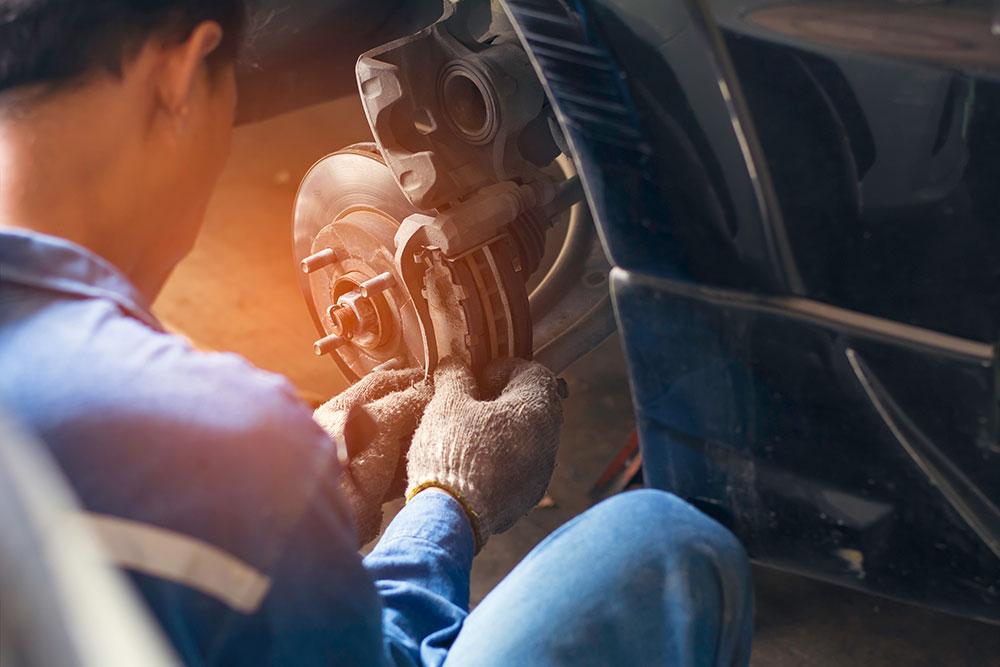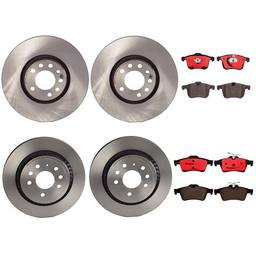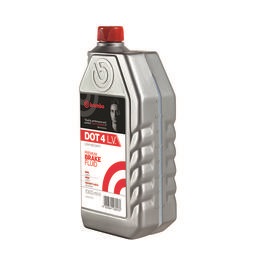What’s the first thing that comes to mind when you think of car performance upgrades? Is it choosing the right brakes? If you’ve answered no to that question, you are among a massive majority of car owners who are interested in improving the performance of their cars.

Brake system upgrades can make you go faster around the track simply by allowing you to brake later and harder during cornering. Yet, braking system upgrades are often the last thing that gets improved on an average project car. This can be rather dangerous. Today we’re going to talk about brake upgrades, how to choose the right brakes for your car and more.
By the time you’re done reading this guide, you should have a solid understanding of how different brake components affect your car’s performance.
Why are Brake Upgrades Important?
We will divide this article into two parts. The first one will deal with upgrading the brakes on your daily driver, the benefits of doing so and more. The other part of the article will focus more on brake upgrades for project cars or track cars.
With that out of the way, why are brake upgrades important?
Being able to stop is much more important than being able to accelerate fast. That much is obvious, or at least it should be obvious. Being able to safely and predictably reduce the speed of your vehicle is imperative for daily driving as well as on-track performance.
If you’re taking your car to the track, you’ll absolutely want to give your brakes a closer look. One of the most common mistakes inexperienced drivers make is hit the track aggressively with stock brakes. Granted, a good portion of modern performance cars have decent brakes, to begin with, but the chances are that you will run into the issue of brake fade.
Brake Fade and Other Issues
Brake fade is a phenomenon that occurs when you brake hard and frequently. It is caused by your brakes reaching a certain temperature where both the pads and discs are no longer performing up to spec. Also, you can have gases from the braking compounds begin to build up between the disc and the pad. As a result, you will lose a decent amount of your braking capabilities at which point it is no longer safe to operate the car.
Granted, modern brake pads aren’t that bad anymore when it comes to developing gaseous layers, but this effect is still present to a certain point.
A most common situation where brake fade occurs is racing. Any time you’re driving aggressively around the track, you’re risking dealing with brake fade. Your chances of experiencing this issue will depend on your braking system, discs, pads, calipers and more.
Another, albeit much less common issue that you can run into while racing with stock brakes, is complete brake failure due to boiled braking fluid.
As you brake, the hydraulic fluid in the system heats up. Depending on the boiling point of said fluid, there’s a chance that it will lose all of its hydraulic properties during intense track days. Once that happens, you’re effectively out of brakes which is about as dangerous as you can imagine.
Upgrading Stock Brakes in Regular Cars
One of the biggest misconceptions regarding brake upgrades is that you have to get a set of massive discs and equally massive calipers. This is even more absurd if we’re talking about regular cars that you plan on using for your daily commute and not much more.
In reality, even doing something simple as flushing the system and adding new brake fluid can be a good enough upgrade. Stock brake systems on vehicles that get used every day usually aren’t up to factory spec anymore. A simple act of refreshing the components can add a lot to your braking ability.
Brake Pads
Brake pads are a wearable component that needs to be changed periodically. One of the absolute easiest ways to improve your car’s braking performance is to get a new set of pads. Not only that, but pads come in a variety of different flavors. The “meat” on the braking side of a pad is a special braking compound. Its purpose is to grip the brake rotor or brake disc and use friction to slow the car down.
Braking compounds can be more abrasive or less abrasive in nature. This will largely depend on the brand you go with but also the type of pad you go with. One thing to keep in mind, which we will discuss in length a bit later, is that stronger braking compounds create more heat.
As we’ve learned at the beginning of this article, excessive heat will induce brake fade. Because of that, sticking with OEM brake pads is the best way to go. If not OEM, you could go one level above OEM and enjoy the benefits of improved braking without too much risk of brake fade.

Brake Rotors
Brake rotors are the other side of the equation. They are also wearable and have a lifespan that is slightly longer than that of quality brake pads. Brake rotors tend to develop grooves over time, get warped due to environmental effects but also due to pure negligence.
Imagine driving a high-speed section of a high way during a rainy day. You’re driving aggressively with plenty of hard braking and hard acceleration. Now imagine running into a massive puddle of water while driving like that? What most see as a nuisance at best is having a very serious effect on the brakes.
Coldwater hitting almost glowing hot rotors can be enough to permanently change their geometry. In some cases, you will feel the imbalance when you step on the brake while you can also expect the brakes to squeal. In more severe cases, the brake rotors will actually warp to a point where they are no longer safe for use.
One of the questions that many car enthusiasts ask themselves is whether or not they should get ventilated discs? After all, that’s what all the cool sports cars have, therefore that must be the right way to go?
Not necessarily. Ventilated rotors are great at reducing brake fade and keeping the temperature at bay, there’s no denying that. However, they are also much harder to warm up and as most you know, cold brakes equal to subpar braking.
The real question you should be asking yourself is whether or not you’ll run those rotors hard enough in your daily commute to sufficiently warm them up?

Upgrading Brakes on Performance Cars
Doing brake upgrades on a performance car that will hit the tarmac mainly on a track is something of a science. There are generally five areas that you’ll want to upgrade with a possible sixth we’ll add for those who want to go above and beyond.
With that said, before you go spending big bucks on massive brake kits, make sure that your existing gear is simply insufficient. Adding more weight to a car is not a good way to make it faster. So, how do you choose the right brakes for your car?
Listen to What Your Car is Telling You
Just like a doctor trying to diagnose a patient, you need to diagnose your car’s braking system. Push it hard around the track and take note of how the system is behaving, how fast are the brakes fading and whether or not you have brake bias. These things alone can tell you where you need to start with your upgrades and how severe the upgrades need to be.
Once you’ve fully assessed the situation, there are four main areas that can be tuned up in order to improve your car’s braking capabilities. You can invest in larger rotors, better pads, larger calipers, improved brake lines, and improved brake fluid. That sixth option we’ve mentioned is a larger master cylinder but more on that later.
Brake Rotors
How can you tell if your car needs larger, beefier rotors? The easiest way to know is if your stock rotors are heating up above normal, developing heat-checking and generally failing to provide necessary braking force when and where you need it.
When upgrading brake rotors, you need to pay attention to brake bias. If rear rotors are locking up before your front rotors are, you have a rear brake bias. If your front rotors are locking up before your rears do, you have a front bias. Now, you won’t be able to eliminate brake bias completely as it depends on a variety of things including the surface you’re driving on, your tires and more. What you can do is avoid adding to it.
What Kind of Rotor Should You Get?
There are two types of rotors you’ll run into aside from the standard OEM part – ventilated drilled rotors and ventilated slotted rotors. We will generally talk about ventilated rotors as we’ll assume that your needs go past standard, plain rotors.
Ventilated Drilled Rotors
Drilled rotors used to be all the rage. You can still see them on performance cars, but not so much on actual racing cars.
There’s a good reason for this. Drilling holes in rotors was thought to be the perfect way to get rid of those pesky gasses that we’ve mentioned earlier as well as any other debris. However, as brake compounds became more efficient, the whole gas thing ceased to be an issue.
High quality drilled rotors such as the Brembo Xtra offer the improved performance as well as the awesome looks that will make your ride stand out.
Ventilated Slotted Rotors
Slotting the rotors by adding a grove in its surface was found to deliver the same benefits as drilled rotors, without all of the negative side effects. As a matter of fact, almost any serious racing today is done on slotted rotors.
Ventilated rotors are the norm as evacuating hot air between two discs has proven to be the most efficient way of keeping the temperature of the rotor at reasonable levels. There are different types of slotted ventilated rotors out there depending on the brand you turn to.
Rotor Size
Increasing rotor size directly increases the available braking surface. Larger rotors mean more material for pad’s braking compound to bite into. However, adding more material also means that you’re now dealing with more mass that needs to be cooled.
Increasing rotors size can also be constrained by your suspension or wheel size, so keep that in mind before you go spending money on massive rotors. With that said, if you need more stopping power, installing a larger rotor is the way to go.

Which Brand to Choose?
Just opening any parts catalog will reveal a whole variety of different brands. The same goes for brake rotors. Brands such as Brembo have a rotor for just about any kind of application. On top of that, this brand has a long track record of quality and reliability.
Brembo’s Sport line of brake discs covers track-oriented performance braking while their Turismo series is there to give you superior braking under normal driving conditions. For example, Turismo discs are a perfect choice for those looking to upgrade their brakes without using a larger rotor or larger aftermarket calipers.
It’s important to note that Brembo offers these in both slotted, drilled and cross-drilled versions. However, you’ll have to check which option is available for your specific car model. For more information, check out our brake rotors section!
Brake Pads
Performance brake pads are a whole different ball game compared to standard brake pads. Much like tires, there are pads optimized for endurance that will last for 100,000 miles and offer mediocre braking, but there are also super abrasive ones that will last a quarter of that at best.
In other words, you need to find out the balance that works best for you. Since we’re talking about performance cars, we’ll focus more on the latter.
Here’s the thing though, not all performance pads are made equal. Some are built for sprint races such as hill climbs where you need that pad to bite in without any warmup. Such pads generally don’t last very long at all.
On the other hand, you might need an endurance pad designed for longer races where the optimal performance is achieved only once the pad is properly warmed up.
The best way to figure out what compound you’ll need is to figure out what kind of driving you’ll be doing the most. With that information in hand, check out different compounds from different brands.
Brembo’s new Low-Met pads are a great example of what a good track day pad is all about. It’s an aggressive pad that bites well right off the bat and works well in high-temperature environments.
If you’re interested in this type of pad, check out our Brembo section for more information.
Beefy Calipers
Big brake kits are awesome, there’s no denying that. They look cool, they make those pads clamp harder on the rotor, what’s not to like? As it turns out, you can’t just go get the biggest and baddest calipers and slap them on your front wheels.
Larger calipers require more fluid to operate as they often have more pistons which are wider than what your braking system was designed for. This results in a softer brake pedal and a lack of brake fluid reserve in the system.
It’s important to know what kind of caliper works with your car. There are numerous brands out there who build awesome kits so you shouldn’t have an issue finding something that fits your needs.

Stainless Steel Braided Brake Lines
One of the often-overlooked parts of a braking system is brake lines. OEM brake lines are usually made of rubber. While that is perfectly fine for daily commuting around the city, rubber doesn’t work all that well on the track. As it’s usually the case with anything performance-related on cars, heat is your worst enemy.
As you’re throwing your car around the track, the brake fluid in your brake’s hydraulic system starts to heat up. Rubber compounds used to make stock brake lines are soft and tend to expand as they heat up. Adding volume to any hydraulic system is a bad idea if you need that system to work properly.
One way to deal with expanding rubber brake lines is to switch them out for stainless steel braided lines. These are much better at dealing with excess heat and a buildup of pressure in the system.
Performance Brake Fluid
One of the last things you can do to improve your braking capabilities is to use performance brake fluid in your system. Standard OEM brake fluid is great for everyday use. The moment you start pushing your brakes hard, you’ll find that stock fluid isn’t going to hold up very well. This is because stock fluid has a relatively low boiling point. Once reached, some of the fluid turns into a gas and that greatly diminishes your braking capabilities.
So, in order to avoid all of that, there are performance brake fluids designed to have a much higher boiling point. In other words, performance fluid remains in its fluid state despite high temperatures which are often present after frequent episodes of hard braking. One great example of performance brake fluid is Brembo’s Premium Brake Fluid DOT 5.1.
They’ve created a formula that features a reduced viscosity compared to your standard brake fluid, all while being able to withstand higher temperatures. This is the type of fluid you’d want to use for track days.
Larger Master Cylinder
Once you add larger calipers and larger rotors, you might find yourself lacking the necessary volume to push enough fluid where it needs to be. One way to address this is to go with a larger bore master cylinder. This is not something many consider a basic upgrade, but we’ve decided to put it out there as it can alleviate some issues associated with larger calipers. Especially those that have up to 8 pistons.
Finding the right cylinder is going to come down to your car make and model. Certain models that are frequently seen on tracks will usually have plenty of aftermarket master cylinders for you to choose from. On the other hand, you might find that your options are not as great if you drive something that’s not as popular.
Tires and Suspension
Before we bring this guide to an end, we need to briefly touch upon tires and suspension. Both of these components can greatly affect your car’s ability to brake efficiently. No amount of 8-piston calipers will stop a car with bald tires. Similarly, if your car bounces off the ground every time it runs over a pebble, you might experience sub-par braking. Keep this in mind as you’re planning your brake system upgrades.
Summary
At the end of the day, upgrading your brakes is much more complicated than just picking the largest rotor and the largest caliper you can find. You really need to sit down and figure out what works for your car. Otherwise, you might find all of your new upgrades making your car slower instead of faster around the track!
If you’re interested in upgrading your brakes and doing it the right way, get in touch with our representatives and we’ll try and help you find the best brake system setup for your vehicle!





